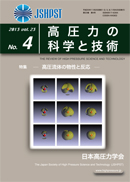Volume 23, Issue 4
Displaying 1-14 of 14 articles from this issue
- |<
- <
- 1
- >
- >|
Foreword
-
2013Volume 23Issue 4 Pages 297-298
Published: 2013
Released on J-STAGE: December 28, 2013
Download PDF (198K)
Reviews—Latest Researches on the Properties and Reactions of High-Pressure Fluids—
-
2013Volume 23Issue 4 Pages 300-308
Published: 2013
Released on J-STAGE: December 28, 2013
Download PDF (604K) -
2013Volume 23Issue 4 Pages 309-318
Published: 2013
Released on J-STAGE: December 28, 2013
Download PDF (580K) -
2013Volume 23Issue 4 Pages 319-324
Published: 2013
Released on J-STAGE: December 28, 2013
Download PDF (359K) -
2013Volume 23Issue 4 Pages 325-331
Published: 2013
Released on J-STAGE: December 28, 2013
Download PDF (452K) -
2013Volume 23Issue 4 Pages 332-338
Published: 2013
Released on J-STAGE: December 28, 2013
Download PDF (465K)
Reviews
-
2013Volume 23Issue 4 Pages 339-346
Published: 2013
Released on J-STAGE: December 28, 2013
Download PDF (473K)
Obituary
-
2013Volume 23Issue 4 Pages 347
Published: 2013
Released on J-STAGE: December 28, 2013
Download PDF (170K) -
2013Volume 23Issue 4 Pages 348-349
Published: 2013
Released on J-STAGE: December 28, 2013
Download PDF (247K)
Laboratory News
-
2013Volume 23Issue 4 Pages 350-351
Published: 2013
Released on J-STAGE: December 28, 2013
Download PDF (290K)
Salon
-
2013Volume 23Issue 4 Pages 352-353
Published: 2013
Released on J-STAGE: December 28, 2013
Download PDF (255K) -
2013Volume 23Issue 4 Pages 354-355
Published: 2013
Released on J-STAGE: December 28, 2013
Download PDF (250K) -
2013Volume 23Issue 4 Pages 356-357
Published: 2013
Released on J-STAGE: December 28, 2013
Download PDF (270K) -
2013Volume 23Issue 4 Pages 358-359
Published: 2013
Released on J-STAGE: December 28, 2013
Download PDF (240K)
- |<
- <
- 1
- >
- >|
